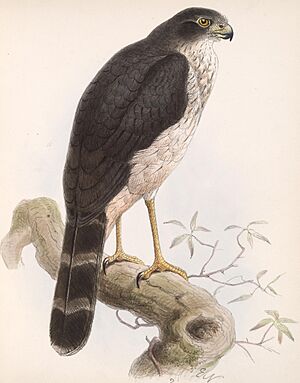Slaty-backed forest falcon facts for kids
Quick facts for kids Slaty-backed forest falcon |
|
|---|---|
 |
|
| Conservation status | |
| Scientific classification | |
| Genus: |
Micrastur
|
| Species: |
mirandollei
|
 |
|
The slaty-backed forest falcon (Micrastur mirandollei) is a cool bird of prey. It belongs to the falcon family, just like other falcons and caracaras. You can find this bird in parts of Central and South America. It lives in countries like Costa Rica, Panama, and many places in South America, but not in Argentina, Chile, Paraguay, or Uruguay.
Contents
About the Slaty-backed Forest Falcon
This falcon is closely related to two other types of forest falcons: the collared forest falcon and Buckley's forest falcon. They are like close cousins in the bird world! There's only one main type of slaty-backed forest falcon, meaning it doesn't have different subspecies.
What Does It Look Like?
The slaty-backed forest falcon is about 40 to 45 centimeters (16 to 18 inches) long. That's roughly the length of a school ruler! Male falcons weigh around 420 grams (15 ounces), while females are a bit heavier, weighing about 500 to 556 grams (18 to 20 ounces). Their wings can spread out to be 65 to 71 centimeters (26 to 28 inches) wide.
Adult falcons have dark gray feathers on their backs and wings. Their head is even darker, but their cheeks are a lighter gray. Their throat and belly are white or creamy white. You might see a few dark lines on their chest from their feathers. Their tail is dark gray with a white tip and usually has three thin white stripes, though these can be hard to see.
Their eyes are yellowish-brown to dark brown. Their beak area (called a cere) is greenish-yellow, and their legs and feet are bright yellow. Young falcons look a bit different. They have brownish-gray upper parts and yellowish-white underparts that look a bit scaly.
Where Does It Live?
This falcon lives in two main areas. One area stretches from Costa Rica through Panama and western Colombia into western Ecuador. The other, much larger area is in the Amazon Basin. This includes eastern Colombia, eastern Ecuador, eastern Peru, northern Bolivia, and east through Venezuela, the Guianas, and northern Brazil all the way to the Atlantic coast.
It loves to live in lowland rainforests, especially places that haven't been disturbed by people. However, it can also be found in older secondary forests (forests that have grown back after being cut down) and sometimes even in more open areas. You'll often find them near rivers or streams. They usually live below 200 meters (650 feet) in elevation, but sometimes they can be found as high as 500 meters (1,600 feet).
How Does It Behave?
Moving Around
As far as we know, the slaty-backed forest falcon stays in the same area all year long. It doesn't migrate to different places.
What Does It Eat?
We don't know all the details about what this falcon eats, but we do know it hunts birds, lizards, and snakes. It usually hunts from the lower or middle parts of the forest, but it will also go down to the ground. Sometimes, it might follow army ant swarms. These ants scare away smaller birds, and the falcon can then catch those birds as they try to escape!
Raising Young
Scientists don't know much about how the slaty-backed forest falcon raises its young. However, other forest falcons in the Micrastur family usually nest in holes in trees. So, it's likely that this falcon does the same!
Its Calls
The main sound the slaty-backed forest falcon makes is a "chanting series." It's a group of 8 to 13 loud, nasal notes that sound like kiiih or kaaah. It also makes a high-pitched eek-eek-eek... sound. It seems to use this call to make smaller birds get angry and mob it. When they do, the falcon might try to catch one of them!
Is It Safe?
The IUCN (International Union for Conservation of Nature) has looked at the slaty-backed forest falcon and says it is a species of "Least Concern." This means it's not currently in danger of disappearing. It lives across a very large area, and there are at least 50,000 adult birds. Even though its numbers are thought to be slowly going down, there are no immediate big threats to it. It's found in many places, but it's usually rare and might only be present in certain spots.


